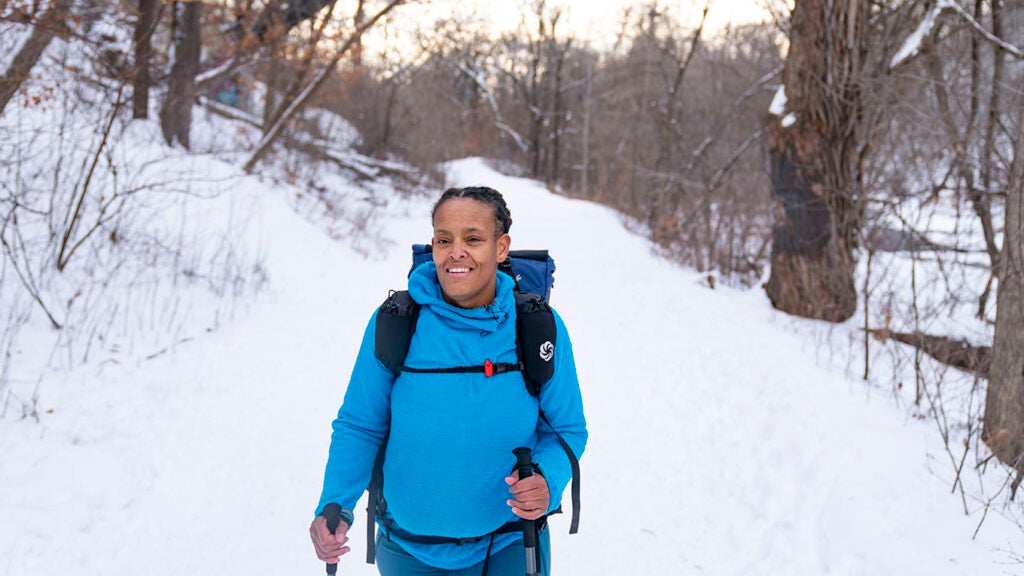Products You May Like
After a long battle against a rare brain disease, Crystal Gail Welcome, a 41-year-old from Jacksonville, Florida, took up running as a spontaneous celebration of her health and perseverance. Then a friend invited her on a short dayhike, where she had a profound encounter with, well, a tree (tale below). She later went on to tackle the Pacific Crest Trail and other cross-country jaunts. Now, Welcome seeks to bring the healing power of hiking to those who need it most.
Backpacker: Tell us about your brain.
CGW: I have a rare brain disease called pseudotumor cerebri, which produces an increase of pressure in my brain. I had many, many surgeries to implant shunts, remove shunts, and try alternate shunts. None worked. Then, in 2014, a doctor recommended a neuromodulator—an implant that regulates the amount of spinal fluid in my brain.
BP: And you manage to hike with that implant?
CGW: I’m currently section-hiking the Great Western Loop in three parts. [Ed. note: The GWL is a 6,875-mile mash-up of the Pacific Crest, Pacific Northwest, Continental Divide, Grand Enchantment, and Arizona trails.] I started last summer and hiked 1,200 miles, and now I’m preparing for part two. I’m section-hiking it so I can leave the trail and recharge my neurological implant every week or two. If I have to use more power or a higher frequency to control my pain—this usually occurs at higher altitudes—then my recharge intervals are more frequent.
BP: How did you get into thru-hiking?
CGW: Nine weeks after my surgery to implant the neuromodulator I ran a half marathon, just because I could. After that, a friend took me on a short cool-down hike in a nature preserve outside of Atlanta. It was buggy, and I was like, “This is not fun.” Then we came to a brook with a tree next to it. In that moment—and I know this sounds silly—I felt so connected to this tree. I thought, “I’m so like this tree. I have roots and branches. All of life is like this tree.” I decided I wanted to experience more of this, so I went to hike the Pacific Crest Trail.
BP: What was your experience on the PCT like?
CGW: I hiked about 600 miles and the trail was therapy for me. Therapy I didn’t know I needed or how to get otherwise. I knew I had to introduce others to this feeling. Once I got off the trail, I went back to school to get my Masters in Adventure Education and Adventure Therapy at Prescott College. I graduated in 2020, the year of Covid and George Floyd.
BP: Have you felt accepted as a Black thru-hiker?
CGW: Race frequently comes up. I am asked why other BI and POC aren’t hiking, as if I am responsible for solving racism in the outdoors. I am also questioned as to how I can afford to hike and/or looked upon with suspicion when I have nice gear, yet other BI and POC hikers never ask me this question. I was the only BI and POC hiker amongst a group of hikers near Mt. Whitney who was asked to show a permit by a ranger. The underlying message is: “What are you doing here?”
BP: What else are you up to?
CGW: I’m living with my partner in rural Minnesota where there aren’t a lot of Black people, let alone Black queer people. After moving here, I thru-hiked the Superior Hiking Trail then went straight to the George Floyd Memorial site with my pack and all my gear. I left my trekking poles at the memorial site as a gesture. They gave me stability and support on my hike, and that’s what we need as a country. I also started a nonprofit to get children of incarcerated mothers outside. Outside, you feel comforted like you’re with a mother. Mother Nature, right?
BP: And this all started with one buggy hike.
CGW: Yep—and that tree! Things are different in nature. We are more connected.
You can follow Crystal Gail Welcome on Instagram: @footprintsforchange
